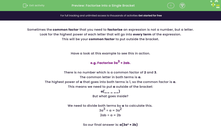Sometimes the common factor that you need to factorise an expression is not a number, but a letter.
Look for the highest power of each letter that will go into every term of the expression.
This will be your common factor to put outside the bracket.
Have a look at this example to see this in action.
e.g. Factorise 3a3 + 2ab.
There is no number which is a common factor of 2 and 3.
The common letter in both terms is a.
The highest power of a that goes into both terms is 1, so the common factor is a.
This means we need to put a outside of the bracket:
a(__ _ __)
But what goes inside?
We need to divide both terms by a to calculate this.
3a3 ÷ a = 3a2
2ab ÷ a = 2b
So our final answer is: a(3a² + 2b)
In this activity, we will factorise expressions into a single bracket using letters or numbers as common factors.








